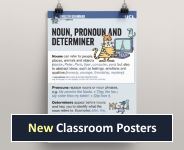Clauses: Further guidance for teachers
Modern grammatical descriptions of English differ in some ways from the accounts in traditional grammars. This can sometimes lead to confusion. Here we note a few important differences in relation to the analysis of clauses and sentences.
Many traditional grammars (including those sometimes referred to in guidance for the National Curriculum and A level) make reference to sentence types. These traditionally fall under the categories of simple sentence, complex sentence and compound sentence. To this you could also add sentence fragments (like Sorry or More coffee?).
In modern descriptive grammar, the clause is taken as a more fundamental unit for grammatical analysis than the sentence. There are good grammatical arguments for this approach, and we follow it here on the Englicious website.
Modern grammars often have little concern with the traditional distinction between sentence types. We have adapted the distinction slightly to adapt it to modern grammatical accounts. While there is considerable agreement between the different grammar models, it is also important to be aware of some differences.
One important point is that modern grammar allows for one clause to be part of another clause. Consider the following example:
- Anna moved to London after she got married.
- Anna moved to London after the wedding.
The whole example in (1) is treated as a main clause, with after she got married being a subordinate clause which forms part of it. Specifically, it functions as an Adverbial within the higher-level clause – just as the preposition phrase after the wedding does in (2). Each of them tells us when Anna moved to London.
Traditional grammar would break the sentence into two parts, with Anna moved to London being the main clause and after she got married being the subordinate clause. But that misses the parallel between (1) and (2).
According to our analysis (following modern grammar), it’s not strictly correct to talk about forming (1) by joining a main clause and a subordinate clause. Instead we talk about using the subordinate clause as part of a larger main clause.
Below is an even clearer example where a subordinate clause forms part of a main clause:
- Sasha believed that he was telling the truth. (Compare: Sasha believed his story.)
Here, that he was telling the truth is what Sasha believed. We can analyse it as a Direct Object within the higher-level clause, in the same way that we analyse his story in Sasha believed his story.
Modern grammar also allows for a clause to form part of a phrase. For example, we can have a relative clause inside a noun phrase:
- He finally shook off the guys who were chasing him.
Here, the guys who were chasing him is analysed as a noun phrase, with the relative clause who were chasing him inside it.
In a traditional grammar model, a clause would generally be seen as containing a finite (or tensed) verb and a Subject. It is true that this is the clearest and most basic type of clause. However, modern grammar also recognises nonfinite clauses, which may or may not have a Subject. Consider this example:
- All I want is for everyone to enjoy the day.
The highlighted element here is treated as a clause because it can be analysed into the same kinds of functional units as a clause. Compare:
- for everyone to enjoy the day
- Everyone enjoyed the day.
In both of these we have a Subject (everyone), a Predicator (the verb, enjoy/enjoyed) and a Direct Object (the day).
Now consider this example:
- All I want is to enjoy the day.
Here the highlighted element has no overt Subject, although we understand ‘I’ (the speaker or writer) as being the one who is to do the enjoying. Although it lacks a Subject, to enjoy the day still has some similarities to other clauses, and can be included as a nonfinite subordinate clause.
Traditional grammar models are not always very helpful when applied to the grammar of spoken English. Anyone who looks at conversational language finds that it can’t be neatly divided into a series of sentences.
For instance, how would you decide where to place sentence boundaries in anauthentic stream of talk like the following? (The symbol string <,> is used to mark a short pause.)
- on the Sunday they had this party in the house and it was all the school kids <,> because my cousin’s a schoolmaster and they had this party and they put some cider in the punch <,> and my cousin left the punch through in the next door and I’m going oh they’re going to spike it they’re going to spike it and he’s going no no they’re too naive to do that [S1A-038 #89–98]
Furthermore, we don’t always talk in ‘complete sentences’, as seen in the following exchange:
- A: I don’t want great big life-size photographs of relatives hanging on the wall thank you
- B: Especially not that side of the family <laugh>
- C: Any side of the family thank you from that era [S1A-007 #160–162]
Here the contributions from B and C are not ‘complete sentences’ in the usual sense. They would be hard to interpret out of context, but make perfect sense within the exchange.
These features of spoken language bring out further advantages of foregrounding analysis in terms of phrases and clauses, rather than sentences.
Welcome!

Englicious is totally free for everyone to use!
But in exchange, we ask that you register for an account on our site.
If you’ve already registered, you can log in straight away.
Since this is your first visit today, you can see this page by clicking the button below.
- Printer-friendly version
- Log in to view or leave comments

